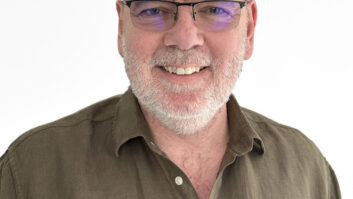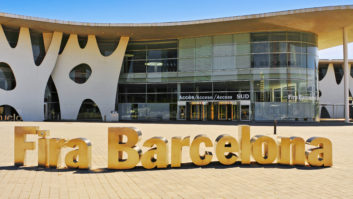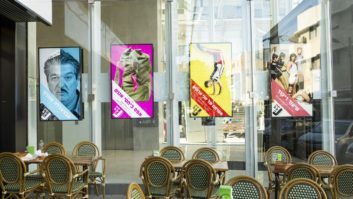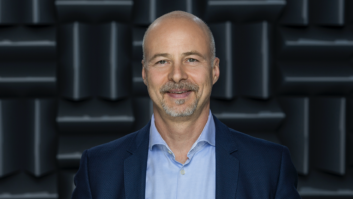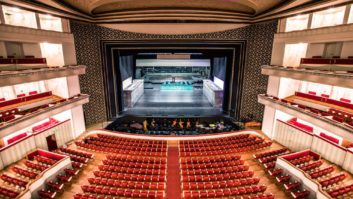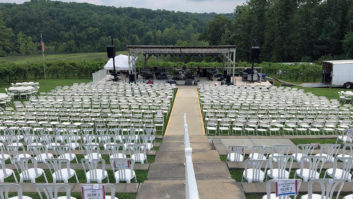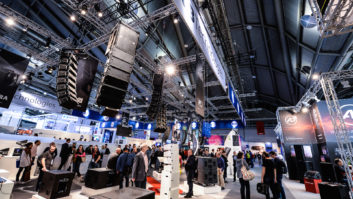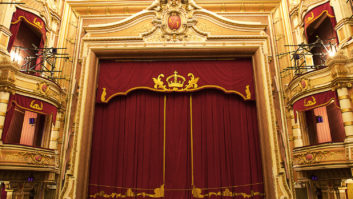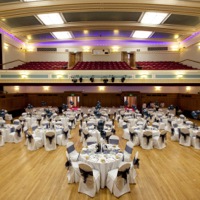
…and audio is merely one of the players – but a pretty damn important one. Theatres and concert halls have traditionally been significant income generators for console and intercom manufacturers, but what has been the impact of ‘analogue sunset’ and more extensive networking? David Davies finds out.
Travel back in time ten or even five years, and it was not uncommon to hear audio described as the ‘poor cousin’ to lighting in terms of small to medium-sized auditorium investment priorities. For many, keeping pace with the rapid evolution of lighting felt like challenge enough. Where significant audio spend was taking place, the focus tended to be on then-emerging line-array systems.
Viewed in this context, the advent of digital consoles as a truly affordable option has been nothing less than revolutionary. Versatile and easy to (re)configure, digital desks have ushered in a new, more malleable era of auditorium audio. With many venues looking to augment income from theatre, music and other live performance with congress events, this new-found flexibility could hardly have arrived at a more opportune moment.
The adoption of digital desks was a trend that quickly assumed momentum – one amplified during the past 18 months by the arrival of increasingly compact desks. These have even proven difficult to resist among those venues inclined to operate primarily on a ‘shell’ basis.
The transition is neatly encapsulated by Richard Ferriday, manager – product support of MUSIC Group Research, parent of PRO console series developer Midas: “In the past, [small /medium-sized auditoriums] would install a small analogue console – just about adequate for smaller, ‘house’ productions, relying upon any larger, incoming productions to bring in their own systems. The advent of digital technology – and the much smaller footprint and considerably greater capabilities of digital – means the initial investment for a sophisticated audio system is much less than with analogue.”
It’s not all good news, of course: fluctuations in the level of touring activity over the past couple of years have led to more days in the dark and, not surprisingly, some tightening of belts. But console makers continue to report good levels of demand, as do intercom suppliers [see Clear-Com box, right], whose case to market has been emboldened by the requirements of increasingly complex productions.
Count on us
An uncertain outlook does mean, however, that venues are thinking more carefully than ever before they commit to new spend. As regards consoles, that generally translates to a desire to accommodate increased channel counts and more powerful recording capabilities. Above all, there needs to be a recognition of new demands – both seen and unseen.
James Gordon, managing director of DiGiCo – whose SD series has racked up significant installations worldwide – confirms: “Installations increasingly have to think further into the future as they are having to predict how venues and spaces are going to be used in the next 10 years. These demands have changed greatly in the past decade, with increased demands on channel counts and, more importantly, bus outputs. They are very aware of this and want to see how systems can be expanded and evolve.”
Demand for the MADI communications protocol (Multichannel Audio Digital Interface) is a case in point. Originally developed in the early 1990s, MADI is anything but new technology, but its proven reliability and high channel count capability have seen it enjoy a surge in popularity of late.
Gordon notes: “MADI would not have been a high demand 10 years ago, but today it is an important solution. It is the standard for recording and connecting digital systems. This means installations need to make sure with a console that they are investing in a future-proofed solution.”
It’s a trend that, admits Gordon, “has really helped DiGiCo because we have a proven track record for our consoles being given additional features and flexibility over time. The SD series’ FPGA [processing] heart means it can be adapted in a way that is simply not possible with old DSP designs. The latest versions of software this year prove that, with almost all consoles getting an increase in every key area; in the case of the SD9, its channel count went up by 20% and its FX processing by 100%.”
Flexibility of control, meanwhile, has turned out to be a significant asset for Allen & Heath, whose iLive series allows an independent mixer to be deployed in conjunction with a variety of control options for maximum flexibility. “The iLive family is a top choice for auditoriums, conference halls and corporate facilities thanks to the flexibility of control and unique concept of the MixRack,” says Nicola Beretta, Allen & Heath digital product specialist. “The ability to have a separate, independent mix ‘brain’ gives room for a host of control options, such as a console in the control room, iPads or iPhones around the hall, wall-plate remote controllers for simple volume control/source selection, or multiple laptops conveniently placed around the building.”
“The most recent new demand is tablet remote control,” echoes Andy Trott, VP and general manager, mixers, microphones and headphones, Soundcraft Studer, adding that the ability to integrate powerful effects, EQ and dynamics into a compact feature-set – and thereby save on seat space – is also regarded as an asset.
Connected world
The advent of more portable control options was always destined to be a spur to further design evolution. But the same can also be said of audio networking, with an increasing number of solutions able to deliver low-latency audio over IP in a way that augments existing infrastructures.
The pace of change here is such that Ferriday suggests that “we will see the last length of copper analogue multicore being pulled into a venue of this type in the very near future, and this can only be a good thing for Midas/Klark Teknik products, which are nearly all now network-compatible, if not networked devices in their own right”.
The vast majority of new-builds are being made networking-ready, while most refits also include “either Cat5 or optical or both cabling infrastructure to be installed into the building”, observes Ferriday. It’s a development that is being driven “by cost and convenience. The price of 48-pair analogue multi compared to Cat5 cable is a compelling reason to go the network route. [In addition] the fact that there are so many digital transport protocols which can be transmitted over Cat5 will drive this further.”
But with no one networking methodology yet to emerge triumphant, the onus is on allowing customers to implement as wide a variety of technologies as possible. So, for example, Allen & Heath’s iLive and GLD mixing systems, remarks Beretta, offer “extensive MIDI and TCP/IP control protocols and no fewer than six audio networking option cards suitable for a digital split between FOH and monitor, multiple system linking, daisy-chaining and distribution, recording and playback.”
Of course, a multiplicity of options obliges manufacturers, distributors and integrators to explain the advantages of the various solutions as clearly as possible. “How practical these are depends on what the client is trying to achieve, and as a console manufacturer we need to be able to explain the advantages and disadvantages of the different solutions,” says Gordon, who highlights DiGiCo’s support for connectivity/networking options including Optocore, SoundGrid, Dante, EtherSound, Aviom and MADI.
Audinate’s Dante is one solution whose profile seems to be growing all the time – not least because its feature-set means that it is perceived by many as a pathway towards full AVB (Audio/Video Bridging) implementation. The AVB project has commanded the support of large swathes of the audio community, its momentum greatly assisted by a comprehensive standards programme and an effective flag-waving organisation in the form of the AVnu Alliance. But with some industry observers sensing a slowness by manufacturers to bring sufficient quantities of AVB-compliant product to market, doubts do remain.
Nonetheless, plenty of people believe that AVB has the capacity to affect the networking landscape for auditoriums. For Beretta, it is set to play an important role in “re-marketing the advantages of audio and video networking. When the first audio-over-Ethernet protocols were launched in the mid-’90s, there were several issues such as latency and synchronisation. Interfacing devices from different brands typically required multiple A-D and D-A conversions, expensive sample rate converters or word clock distribution.”
New TCP-IP friendly protocols have improved the situation dramatically, and now “the promise of an all-encompassing set of standards for audio and video transport is dramatically changing the way technicians, contractors, operators and sound engineers seize these opportunities”, says Beretta.
Trott agrees that networking momentum is continuing to build and will probably reach “a level of maturity in two to three years”. But he also points out that “not everyone needs or wants a network, so there is a balance of with and without. It does depend on how scaleable and flexible an installation needs to be, and what it might need to interface to.”
Dependable business
No sector can ever be immune to broader economic circumstances, but the need to accommodate diverse schedules efficiently and cost-effectively has kept auditoriums business healthy. In fact, landmark projects have been rather plentiful of late; Gordon, for example, cites the forthcoming multi-space Star Project in Singapore that is being equipped with “almost every model from the SD series – from the large SD7s in the main venue through to SD9s for the small event spaces”.
With more and more venues completing the transition to digital consoles, it is logical to expect a plateau of some kind to be reached in the next couple of years. Fortunately, for the audio sector as a whole, the networking revolution appears destined to keep the order books busy for a long time to come. n
www.allen-heath.com
www.clearcom.com
www.digico.biz
www.midasconsoles.com
www.music-group.com
www.klarkteknik.com
www.soundcraft.com
www.studer.ch
www.yamahacommercialaudio.com
